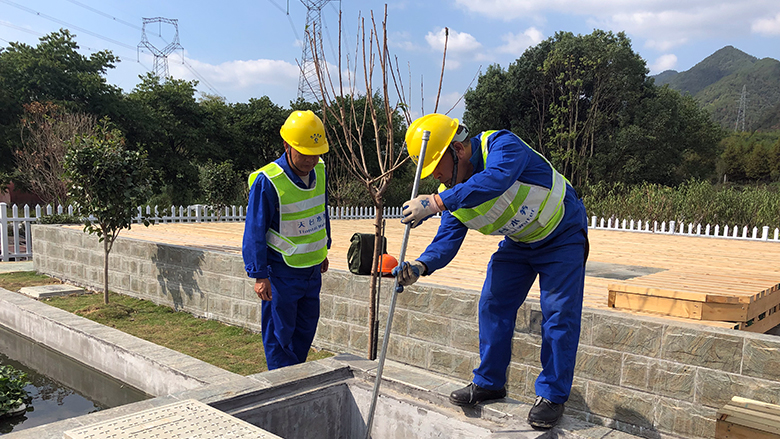Since 2014, the World Bank has been working with Zhejiang to change this through the Zhejiang Water Supply and Sanitation Project and improve access to these services for rural residents.
Workers are laying sewer pipes that will connect all households in Dongchen Village to a sewerage collection and treatment network. Dongchen is one of the 500 villages in four counties (Tiantai, Fuyang, Anji and Longquan) where the World Bank-financed Zhejiang Rural Water Supply and Sanitation Project is being implemented.
Community participation is considered a key factor for the success of the project. Villagers were informed and consulted during project preparation. Work proceeded only after 75% of them agreed to it. During the construction period, a village representative assigned by the village committee helped supervise the quality of construction.
Household connection addresses the last-mile challenge as the new network connects everything that goes down the plughole in the kitchen, bathroom, toilet and laundry.
The treatment station in Zhilu Village, which began operation in September 2019, serves 160 households. Bio-trickling filer technology is used. “It is a traditional, simple and low-cost technology that anyone with some basic education and sewerage experience can operate and maintain,” said Chen Bobo, an engineering manager from the project management office.
The station normally treats about 30 cubic meters of domestic sewage a day and is expected to run at a full capacity of 50 cubic meters during the Chinese New Year when all migrant workers return home for the holidays. Treated water flows into a nearby creek and can be used for irrigation or gardening.
The village continue to play a part in maintaining the facilities through a formal agreement signed between the county water company and village committee to define respective responsibilities. “Villagers must make sure that food and other wastes don’t get into the drain pipes, and the water company is responsible for maintaining the sewer mains and treatment station,” said Chen.
The village committee assigns an inspector to tour the facilities regularly to remove mud and debris from the manholes. Problems that they cannot fix themselves are reported to the water company. Protection of the sewage facilities is now written into the village code of conduct. Whoever causes damage to the sewer pipes will be blacklisted on the village bulletin board.
Access to sanitation services has made a difference in the life of the rural residents. Granny Xu has a new flush toilet installed in her bedroom. “We only had open pits before. Now we have toilets in our home,” said Wang Aixian, Granny Xu’s daughter-in-law.
“We used to put sewage in a bucket and carry it outside to pour in a ditch. The ditch smelled terrible in the summer and there were many rats and flies,” said Ye Ya’e, a village resident in Jietou Township. “Now we can pour it directly down the drain.”
The project has also built community toilets and cleaned up ditches and ponds to improve the overall environment in rural villages. The new community toilets not only provide convenience to residents but also encourage a healthier lifestyle. Renovated ponds, with clean water and beautiful surroundings, are favorite places for older residents to gather, relax and do exercise.
Rural sewage discharge standards developed by the project also informed the formulation of government standards. “The project provided technical information and experience from selected pilots and promoted the promulgation of our provincial rural sewage treatment and discharge standards in 2015,” said Han Li, a deputy division director from the Zhejiang provincial department of ecology and environment.
Zhejiang was the first province to introduce rural sewage standards in China. Before then, urban sewage standards were applied to rural areas, which was inappropriate and expensive to build and operate.
With the project still underway, about 110,000 households with a total of one million people are expected to benefit from improved sanitation services upon its completion by the end of 2020. Other provinces in China can also learn and replicate the rural sewage management lessons from the project.
Li Feng, a deputy division director of the Zhejiang Project Management Office, described the characteristics of the project as “innovation, demonstration and guidance”. “The project has brought internationally advanced technology and management concepts and contributed to the development of the provincial rural wastewater standards, establishment of rural wastewater treatment services, institutional capacity building, and farmers’ participation in project planning, design, construction and maintenance,” he said.

